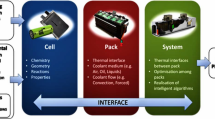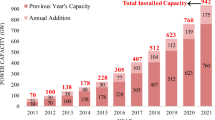Abstract
Smart, intelligent and sustainable power consumption model in residential sector received attraction of the researchers in last couple of years. Numerous techniques have been implemented for green and smart power management but the problem of minimum power consumption without compromising user comfort in green buildings is a big challenge to the researchers. In the past, we have presented power consumption optimization models for green buildings which are constructed on principles of Particle Swarm Optimization (PSO) and Genetic Algorithm (GA). Up-to some extent, the previous intelligent models accomplished better output results, but the results shows that there is space to improve the results furthermore. In this paper, we propose an advanced energy optimization and energy control model based on multiprocessing, ensemble of PSO and GA named Advanced Energy Optimization (AEO) to provide better occupants comfort index and efficient power utilization of the energy sources. The focus of the proposed AEO model is to maximize occupant’s indoor comfort and minimize power consumption. The paper also emphases on the application of a simulator to control the actuators and update the indoor environment. The proposed AEO intelligent building model delivers power efficient green environment by minimizing power utilization and enhancing occupant’s comfort as opposed to GA based power consumption model (GAP). The proposed AEO model also provides better comfort index as compared to GAP, Single Optimization with Hybrid Prediction (SOHP), PSO and Ant Bee Colony with Knowledge Base (ABCKB) models. The results shows the usefulness of the proposed AEO model in reducing consumed power and improving the user’s comfort as compared to existing models. The model also control the building actuators based on the control information’s provided by the model.







Similar content being viewed by others
Abbreviations
- T:
-
Temperature
- L:
-
Illumination
- A:
-
Air-quality
- CP:
-
Consumed power
- AP:
-
Adjusted power
- USP:
-
User set parameters
- SCP:
-
Smooth consumed power
- \(\mathbb{G}\) :
-
Total number of generations
- η:
-
Number of successive generations
- β1, β2, β3 :
-
Consumer defined elements [0, 1]
- eT :
-
Error difference in temperature
- ceT :
-
Change in error difference in temperature
- eL :
-
Error difference in illumination
- eA :
-
Error difference in air-quality)
- Tset, Lset, Aset :
-
User set parameters
- AE:
-
Power source in total (outside and inside energy sources)
- RP:
-
Required power to building
- ME:
-
Maximum energy provided by the outside or inside energy sources
- PCP:
-
Predicted consumed power
- OF:
-
Objective function
- R:
-
Measurement noise covariance
- Q:
-
Process noise covariance
- j:
-
Time
- θ:
-
Weight element
- d:
-
Operation energy for air-quality
References
Ali, S., & Kim, D. H. (2013). Optimized power control and comfort management in building environment. In FTRA-AIM advanced IT, engineering and management conference (pp. 145–146).
Ali, S., & Kim, D. H. (2013). Effective and comfortable power control model using Kalman filter for building energy management. Journal of Wireless Personal Communication, 73(4), 1439–1453.
Ali, S., & Kim, D. H. (2015). Optimized power control methodology using genetic algorithm. Journal of Wireless Personal Communication, 83(1), 493–505.
Ali, S., & Kim, D. H. (2016). Enhanced power control model based on hybrid prediction and preprocessing/post-processing. Journal of Intelligent and Fuzzy Systems, 30(6), 3399–3410.
Wang, Z., Yang, R., & Wang, L. (2010). Multi-agent control system with intelligent optimization for smart and energy-efficient buildings. In Proceedings of the 36th annual conference of the IEEE industrial electronics society (pp. 1144–1149).
Wahid, F., Ghazali, R., & Ismail, L. H. (2019). An enhanced approach of artificial bee colony for energy management in energy efficient residential building. Journal Wireless Personal Communication, 104(1), 235–257.
Dounis, A. I., & Caraiscos, C. (2009). Advanced control systems engineering for energy and comfort management in a building environment—A review. Renewable and Sustainable Energy Reviews, 13(6–7), 1246–1261.
Wang, Z., Yang, R., & Wang, L. (2010). Multi-agent intelligent controller design for smart and sustainable buildings. In Proceedings of 4th annual IEEE international systems conference (pp. 277–282).
Emmerich, S. J., & Persily, A. K. (2001, March). State-of-the-art review of CO2 demand controlled ventilation technology and application. National Institute of Standards and Technology, Technology Administration, US. Department of Commerce.
Levermore, G. J. (1992). Building energy management systems: An application to heating, natural ventilation, lighting and occupant satisfaction (2nd ed., p. 1992). London: E & FN SPON.
Bernard, C., Guerrier, B., & Rasset-Louerant, M. M. (1982). Optimal building energy management. Part II: Control. ASME Journal of Solar Energy Engineering, 114, 13–22.
Curtis, P. S., Shavit, G., & Kreider, K. (1996). Neural networks applied to buildings—A tutorial and case studies in prediction and adaptive control. ASHRAE Transactions, 102(1), 732–737.
Kolokotsa, D., Stavrakakis, G. S., Kalaitzakis, K., & Agoris, D. (2002). Genetic algorithms optimized fuzzy controller for the indoor environmental management in buildings implemented using PLC and local operating networks. Engineering Application of Artificial Intelligence, 15(5), 417–428.
Kusiak, A., Li, M., & Zhang, Z. (2010). A data-driven approach for steam load prediction in buildings. Applied Energy, 87(3), 925–933.
Siroky, J., Oldewurtel, F., Cigler, J., & Privara, S. (2011). Experimental analysis of model predictive control for an energy efficient building heating system. Applied Energy, 88(9), 3079–3087.
Mossolly, M., Ghali, K., & Ghaddar, N. (2009). Optimal control strategy for a multi-zone air conditioning system using a genetic algorithm. Energy, 34(1), 58–66.
Wang, Z., Wang, L., Dounis, A. I., & Yang, R. (2012). Multi-agent control system with information fusion based control model for smart buildings. Applied Energy, 99, 247–254.
Bluyssen, P. M., Aries, M., & Dommelen, P. V. (2011). Comfort of workers in office buildings: The European HOPE project. Building and Environment, 46(1), 280–288.
Marino, C., Nucara, A., & Pietrafesa, M. (2012). Proposal of comfort classification indexes suitable for both single environments and whole buildings. Building and Environment, 57, 58–67.
Yumurtaci, R. (2013). Role of energy management in hybrid renewable energy systems: Case study-based analysis considering varying seasonal conditions. Turkish Journal of Electrical Engineering & Computer Sciences, 21, 1077–1091.
Huang, W., & Lam, H. N. (1997). Using genetic algorithms to optimize controller parameters for HVAC systems. Energy and Buildings, 26(3), 277–282.
Obara, S., & Kudo, K. (2003). Multiple-purpose operational planning of fuel cell and heat pump compound system using genetic algorithm. Transaction of the Society of Heating, Air-Conditioning and Sanitary Engineers of Japan, 9(1), 65–75.
Awada, M., & Srour, I. (2018). A genetic algorithm based framework to model the relationship between building renovation decisions and occupants’ satisfaction with indoor environmental quality. Building and Environment, 146, 247–257.
Li, Nan, Lin, Yang, Xiaodong, Li, Xiangdong, Li, Jiyuan, Tu, & Sherman, C. P. C. (2019). Multi-objective optimization for designing of high-speed train cabin ventilation system using particle swarm optimization and multi-fidelity Kriging. Building and Environment, 155, 161–174.
Van, E. R. J. (1996). The application of neural network in the forecasting of share prices. Finance and Technology Publishing.
Rodriguez, C. P., & Anders, G. J. (2004). Energy price forecasting in the Ontario competitive power system market. IEEE Transactions on Power Systems, 19(1), 366–374.
Li, G., Liu, C. C., Mattson, C., & Lawarree, J. (2007). Day-ahead electricity price forecasting in a grid environment. IEEE Transactions on Power Systems, 22(1), 266–274.
Hong, Y. Y., & Lee, C. F. (2005). A neuro-fuzzy price forecasting approach in deregulated electricity markets. Elect Power Syst Res, 73(2), 151–157.
Mustafaraj, G., Lowry, G., & Chen, J. (2011). Prediction of room temperature and relative humidity by autoregressive linear and nonlinear neural network models for an open office. Energy and Buildings, 43(6), 1452–1460.
Kyungtae, Y., Rogelio, L., Pedro, J. M., & Heejin, C. (2012). Building hourly thermal load prediction using an indexed ARX model. Energy and Buildings, 54, 225–233.
Radisa, Z. J., Aleksandra, A. S., & Branislav, D. Z. (2015). Ensemble of various neural networks for prediction of heating energy consumption. Energy and Buildings, 94, 189–199.
Kangji, Li, Chenglei, Hu, Guohai, Liu, & Wenping, Xue. (2015). Building’s electricity consumption prediction using optimized artificial neural networks and principal component analysis. Energy and Buildings, 108, 106–113.
Betul, B. E., & Aksoy, U. T. (2009). Prediction of building energy consumption by using artificial neural networks. Energy and Buildings, 40, 356–362.
Wong, S. L., Wan, K. K. W., & Lam, T. N. T. (2010). Artificial neural networks for energy analysis of office buildings with daylighting. Energy and Buildings, 87, 551–557.
Melek, Y. (2008). Energy-savings predictions for building-equipment retrofits. Energy and Buildings, 40, 2111–2120.
Sandels, C. J., Widen, L. N., & Andersson, E. (2015). Day-ahead predictions of electricity consumption in a Swedish office building from weather, occupancy, and temporal data. Energy and Buildings, 108, 279–290.
Lapedes, R., & Farber, R. (1987). Nonlinear signal processing using neural networks: prediction and system modeling. Technical report LA-VR87-2662. Los Alamos, New Mexico: Los Alamos National Laboratory.
Holland, J. H. (1975). Adaptation in natural and artificial systems (p. 1975). Ann Arbor, MI: The University of Michigan Press.
Zadeh, L. A. (1968). Fuzzy algorithms. Information and Control, 12(2), 94–102.
Acknowledgements
This resarch was supported by Energy Cloud R&D Program through the National Research Foundation of Korea (NRF) funded by the Ministry of Science, ICT (2019M3F2A1073387), and this research was supported by Institute for Information & Communication Technology Planning and Evaluation (IITP) grant funded by the Korea Government (MSIT) (No.2019-0-01456. AutoMaTa: Autonomous Management framework based on Artificial Intelligent Technology for adaptive and disposible IoT). Correspondence: Do-Hyeun Kim.
Author information
Authors and Affiliations
Corresponding author
Additional information
Publisher's Note
Springer Nature remains neutral with regard to jurisdictional claims in published maps and institutional affiliations.
Rights and permissions
About this article
Cite this article
Ali, S., Kim, DH. Simulation and Energy Management in Smart Environment Using Ensemble of GA and PSO. Wireless Pers Commun 114, 49–67 (2020). https://doi.org/10.1007/s11277-020-07349-4
Published:
Issue Date:
DOI: https://doi.org/10.1007/s11277-020-07349-4




